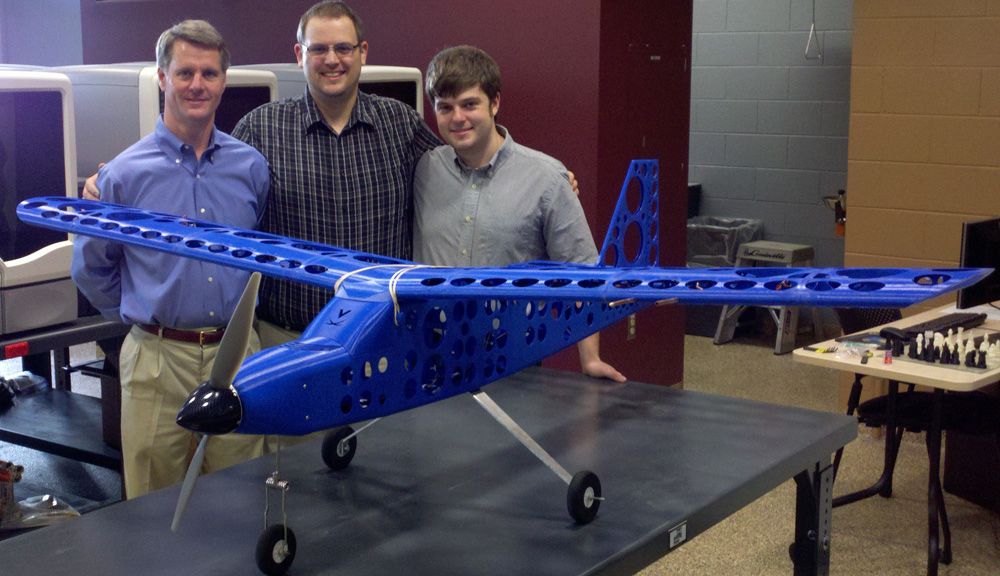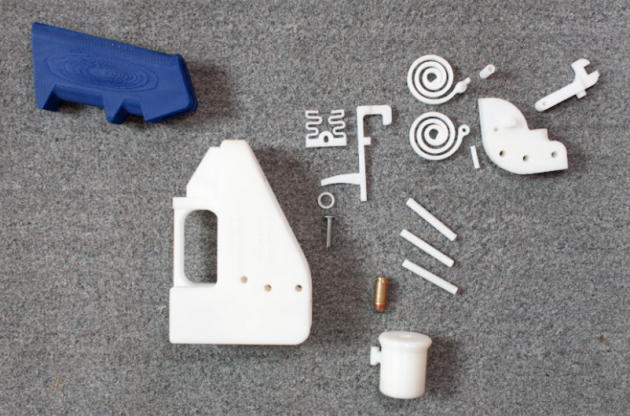3D Printing: Imagine A Brigade Producing Parts On Battlefield
Posted on
Additive manufacturing, known to the public as 3D printing, may profoundly improve combat readiness and the defense industrial base far more than imagined by most proponents. But the Pentagon must account for the way different organizations measure performance, or it will be doomed to long delays and costly failure.
Additive manufacturing can be used to produce items that are impractical or impossible to make using traditional manufacturing methods because it builds them one layer at a time rather than machining, casting or cutting. Because it is computer controlled, complexity imposes few costs and designs can be quickly and easily altered, promising “mass customization” that is impossible using traditional mass manufacturing methods. Traditional manufacturing requires mass production to justify the costs of buying and building the tools to make an item. 3D printers can make items in much smaller facilities just about anywhere because the power, transportation, and vast floor space for tools and raw materials aren’t needed to make huge batches. Design files can be quickly shared electronically and produced anywhere.
Imagine a company or brigade able to produce repair parts on the battlefield. The Army alone spends billions of dollars buying parts every year. Every Army unit carries large parts stockpiles to keep rolling. This is costly and adds a huge burden to a unit as it deploys and in moving around the battlefield. A unit can’t carry everything, and it’s very difficult to predict what parts will be needed, so the Army uses various methodologies to figure out the most important ones on hand, balancing against cost and bulk. When a unit needs a part it doesn’t have, equipment can sit for weeks until a replacement part is shipped all the way from a depot or the manufacturer. Worse yet, sometimes the part isn’t available at all, triggering a potentially lengthy acquisition process. This problem has increasingly plagued the US military. Fewer manufacturers are interested in producing small batches of specialized military items for the fleets that have dwindled from their Cold War expanse. The explosion of unique, constantly evolving low-density equipment used in Iraq and Afghanistan has exacerbated this issue.
This problem has forced the US military to “pure-fleet” designs and make them as multifunctional as possible. Having a single, common platform that shares most of the same repair parts allows maintainers to service their equipment with a smaller selection of parts on hand. But cramming diverse missions into the same platform involves compromises and doesn’t always work well — as exemplified by the F-35, which is slated to replace a diverse array of aircraft. Moreover, systemic flaws are eventually discovered in every design, often leading to usage restrictions or stand-downs until they are corrected.
Additive manufacturing could rescue the US military from the over-reliance on homogenous fleets prone to systemic flaws. Because 3D printers aren’t tied to mass production to meet economies of scale, they could support a diverse equipment fleet using different subsystems and components. Commanders could regain specialized equipment optimized for the job or quickly reconfigure equipment to optimize for the mission or conditions without the logistics and cost penalty. The acquisition system could avoid endless delays pursuing perfect designs for conflicting missions. Designs could start out with achievable, modest goals and continually evolve over their lifetime as conditions change or technology improves.
The Defense Department is very interested in 3D printing technology
, so how can it successfully adopt it? First, the department must understand how different agents in the logistics system measure performance. The Army had extensive fabrication capabilities before that allowed it to repair items but the service dismantled most of it in the early 2000s. Unless we understand why, we are doomed to repeat the same mistakes, expensively.
DoD must target pragmatic users who are likely to eagerly accept the current level of performance provided by 3D printers now. While 3D printing currently has limits, it can make items on site, including items impractical or impossible with traditional manufacturing methods, often with superior attributes. Some 3D printers are limited to a single material, but this is changing quickly and some machines can already fabricate custom circuit boards. 3D printers require a feedstock (powdered metal, plastics, etc.) to produce items, so making simple, large, massive items such as road wheels, torsion bars, body parts, or armor on the battlefield would have limited advantages. Items produced by a typical 3D printer may not be as cost effective or as reliable as a manufactured item. Traditional manufacturing methods will retain some advantages for some time. Early adopters must find current capabilities acceptable. Moreover, a 3D printing solution must be simple and reliable to operate, and robust enough for field work.
To identify these eager early adopters and critical obstacles, we need to understand how this technology interacts with the rest of the logistics system and how agents within it measure effectiveness. Manufacturers often make a substantial portion of their revenue from after-market service and sales, including supplying parts. Designs are often intellectual property of the company that designed them, and some of them are classified. Any plan to use 3D printing technology must include a way to legally license the designs and to protect them from unauthorized disclosure. Manufacturers will continue to be critical in the whole lifecycle of equipment and the ones who cooperate will gain access to design improvements from experienced users in the field. The return to more diverse equipment fleets will shift emphasis to lucrative design and development work.
Program managers, item managers, and others in the DoD supply chain ensure that parts meet design specifications, with a sharp focus on reliability and cost. Services expect their supply chain managers to be particularly ruthless as defense budgets decline. Program managers will be very reluctant to risk equipment failures or accidents, especially in programs already at risk. Organizations currently involved in the DoD supply chain are not likely to support fielding them until the technology matures to match a broad spectrum of traditional manufacturing methods, particularly for cost and reliability. Importantly, this group focuses on the purchase price for repair parts, but not the cost, risk, or delays from shipping or equipment downtime. Here too, 3D printers present the opportunity for designs to evolve quickly as conditions change, keeping programs relevant in times of uncertainty, and quickly redressing design flaws.
End users (commanders, operators, and mechanics) value equipment readiness, performance, and safety above all. This group must often resort to removing parts from one vehicle to get another vehicle operational or operate the equipment with degraded capabilities. Sometimes they use field expedient methods to get a piece of equipment through a mission. Mechanics outline the risks for the commander, who must weigh all the risks to make a decision.
Everyone involved in maintenance in forward units perform under extreme weather conditions, fatigue, and intense pressure to get equipment back into the field. Therefore, any 3D printer, or suite of tools to help them fabricate parts locally must be simple, reliable, and convenient or they just won’t use it. If a part is available, it is much easier to take it off the shelf and fix the equipment than to take the time and effort to figure out and wait for complex equipment, especially if it fails or produces inferior results. However, if it is simple to use, provides a useable part when they need it — even if the part only lasts long enough to get the equipment through the current battle — they will eagerly use it. Software tools for modifying parts and sharing design ideas would help exploit the advantages of 3D printing technologies and improvements from soldiers in the field. Fabricating or modifying some parts entails greater risk of failure than others. Maintenance and operator manuals should include guidelines categorizing parts by risk level for fabrication to facilitate deliberate risk management and a revised structure to allow rapid incorporation of the best modifications.
So what should the Pentagon do right now? It should immediately seek a vendor who can provide a simple, reliable, robust printer capable of operating in the field and begin getting feedback from ordinary deployed mechanics (not specialized technicians) to make it usable, even if only for a limited range of parts. Units in the field have very strong incentives to adopt a well-integrated, reliable, and reasonably cost effective 3D printing solution immediately if it could truly improve combat readiness at critical times. These units would also have strong incentives to drive improvements to the technology while gaining valuable insights and experience with them and how best to use them in concert with other capabilities. This should take place in delivery-sensitive areas like remote forward operating bases or small Navy ships where on site production will have the greatest impact. Well integrated, reliable, and simple to use 3D printers in forward deployed units could play an important niche role in producing repair parts on the battlefield immediately and make substantial improvements to readiness and adaptation. Place focus on adaptability and flexibility and the mindset that allows soldiers to overcome unexpected obstacles, not material solutions.
This will involve risks, risk of time, equipment, and even lives in the event of a tragic accident, but this must be balanced against the time, money, and lives saved in combat through greater adaptability and versatility and a force habituated to creative thinking. When considering the costs, the services must also consider the opportunity cost of equipment downtime and risk, particularly at critical moments, as well as the cost of shipping repair parts to distant battlefields. DoD should not wait until this technology matures, or field it from the top down, but begin using and gaining experience with it in forward deployed units immediately. 3D printers will rapidly improve their capabilities over time and produce a wider variety of parts when and where they are needed the most. They will also produce the opportunity to gain knowledge from the people who use equipment to improve them in ways we cannot yet anticipate.
Army Lt. Col. Jonathan Jeckell is a logistics planner currently serving in Afghanistan. The views expressed here are his and do not represent the views of the Departments of the Army or Defense.
Subscribe to our newsletter
Promotions, new products and sales. Directly to your inbox.


